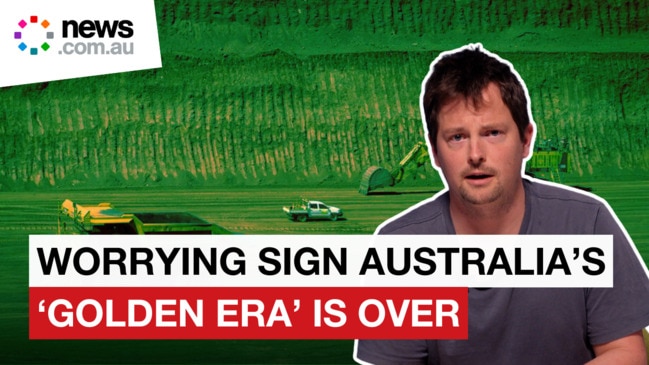
The long years of the Australian economy getting an easy ride on China’s increasing demand for our iron ore are coming to an end, as the Chinese economy slows and reshapes to a more modern “capital light” structure.
While Jim Chalmers is now warning that the slowdown in the Chinese economy could mean weaker iron ore prices, which could leave the federal budget $3bn worse off over the next four years, this week’s earnings results are providing more granular information on China’s impact on the big Australian miners.
The price of iron ore, which has a big impact on the earnings of BHP, Rio, Fortescue, and Gina Rinehart’s Hancock Prospecting (and in turn federal and state coffers) has fallen from a high of more than $US140 a tonne in January to levels of around $US98 a tonne this week.
Weak demand from China has been the biggest single force behind the fall.
While some observers are arguing there may be some short-term issues at play, the collapse in prices has been a bell ringing that the peak of the China boom – as it has positively affected Australia – has well and truly passed.
The more diversified BHP, which reported its results on Tuesday, noted that the Chinese economy was changing, moving past the “steel intensive” stage of its development.
Releasing BHP’s results, chief executive Mike Henry argued his company had foreseen the change, with China moving past its initial infrastructure spending boom that has underwritten its demand for steel, towards a more mature economy.

“As they move past that initial build out of steel in the economy, the ongoing economic growth becomes less steel intense, and you have more scrap coming into the steel cycle,” he told analysts.
“Steel demand plateaus and ultimately moves into decline. We believe (China’s demand for) steel has plateaued, albeit at a quite high level of over a billion tons per annum.”
The key concern at the moment, he noted, was the weakness of the Chinese property sector.
Henry argued that this could well turn around with “some policies we think are going to aid the property sector in the year ahead” as well as demand from sectors such as ship building and the car industry could help boost demand for steel.
Henry also pointed out that the supply side of the iron ore market was changing, with the prospect of the first iron ore from the giant Simandou project in Guinea coming onto the market from next year.
The mine, which is 42.5 per cent owned by Rio, has the potential to scale up to producing 120 million tonnes a year in the next few years.
While this could be a bit on the optimistic side, the combination of slowing or “plateauing” demand for steel in China and some extra supply coming onto the market means that the era of Australia riding on the back of heady iron ore prices has come to an end.
But, as Henry pointed out, the change in the Chinese economy was seeing an increase in demand for other commodities that Australia could supply.
“China’s economic transition could accelerate its demand shift increasingly towards ‘future facing’ commodities”, he said, such as copper and potash.
But while Henry was understandably focused on the future, the fact is that iron ore makes up the biggest single source of BHP’s current earnings and is the biggest single factor in determining how much it pays out to its shareholders.
At 5 per cent, China’s economic growth rate is still the envy of many economies around the world and is an impressive result in some ways, given its sheer size.
But the era of almost 10 per cent-a-year growth for China, which augured so well for Australian iron ore and coal is not coming back.
On Wednesday, there will be more information from Twiggy Forrest’s Fortescue Metals Group, with iron ore sales to China playing a much more critical part in its earnings than BHP.
Concern about the outlook for iron ore prices has been reflected in the big fall in Fortescue’s share price this year, from a high of almost $30 in January to about $18.56 on Tuesday.
Forrest, will not be briefing analysts on Wednesday’s results, leaving it to Dino Otranto, who has been chief executive for the past year.
In July FMG reported that it had recorded record shipments of iron ore in the June quarter of 53.7 million tonnes – 10 per cent higher than the June quarter of 2023.
This brought its total shipments for the year to 191.6 million tonnes – marginally below the 192 million tonnes shipped in the previous financial year.
But while production and shipments over the full year may be steady, compared with the 2023 financial year, the company’s earnings are expected to be hit by the fall in the iron ore price.
Just what outlook it has for the year ahead will also be closely watched by FMG shareholders who have long enjoyed its generous franked dividends.
Meanwhile, the Treasurer is understood to be set to visit China soon to see for himself what is going on.
Reports of strong levels of capital outflow from China also do not auger well for the Chinese economy with ANZ economists observing last week that the country’s role as a “magnet” for foreign investment also turning around amid reports of decoupling with the rest of the world.
While more information will come from FMG on Wednesday, it is already clear that China 2024 is a very different place to the one that underwrote such strong growth – and handy budget revenues for Australia in the past.






Australian winemakers may be enjoying their return to China, but the impact of the transformation of the economy of our second-biggest trading partner is having a more sober impact on the broader economy.